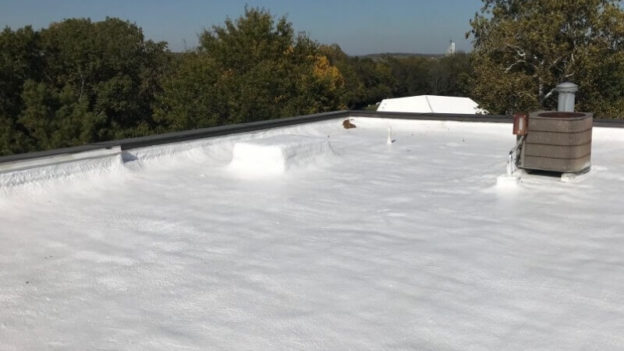When it comes to getting a roof fixed or repaired, or even a completely new roof installed – there are a lot of different options. Sometimes, it can be hard to know where to start. There’s actually one new type of roofing solution that’s growing in popularity in recent years for good reason.
Not only is it a cost-effective roof replacement option, it’s also durable and long-lasting. What is it called? Fluid applied roofing system.
If you’re new to roofing in general or especially this type of roof replacement solution. you’re in the right place. In this article, we’re going to drill down on some of the issues surrounding fluid roofing. Why is it a good option for your roof? Are there any drawbacks associated with fluid roofing? And first of all – what exactly is fluid roofing in the first place? Let’s have a look….
What is fluid applied roofing system?
Fluid applied roofing system is fast becoming one of the easiest, cheapest and most durable ways to repair a roof. But what actually is it? Let’s have a look.
Fluid applied roofing is the process of waterproofing a roof by applying a special liquid. It’s quite a versatile process and can be used to waterproof new roofs or fix existing ones. It can be used for a range of different roof types including shingles, as well as a number of different shape roofs.
What are the benefits of fluid roofing?
Fluid roofing systems are getting a lot of positive traction for good reason. It comes with a number of key benefits. Firstly, fluid applied roofing is extremely versatile. As we’ve already touched on, it can be used for a number of different roof types, materials and shapes. This makes it an important product in a wide-range of roofing solutions.
The benefits don’t stop there. When applied, fluid applied roofing forms an rubber-like waterproof membrane that’s extremely flexible. That means it’s capable of stretching and returning to it’s original state, which makes it both durable and cheap. It’s a great way to waterproof a roof, either new or existing. Especially in areas that experience extreme weather conditions which can cause roofs to shrink and expand.
Fluid applied roofing is also extremely quick and easy to install. Unlike some other waterproofing solutions that could take days to install, fluid applied options might only take a matter of hours. This easiness to install does not detract from how long-lasting a fluid applied roof is. And they are some of the longest lasting in the industry.
Fluid applied roofs are a cheap and effective solutions for all sorts of roofs including balconies and terraces, along with established and traditional roofs. Fluid applied roofs out-perform much of the competition one a number of different tests and metrics.
While you can find slightly cheaper proofing options like felt, this doesn’t take into consideration the important aspect of cost-effectiveness over longer periods. Yes, your felt roof might be cheaper to install – but it will last nowhere near as long. That means you’ll have to repair or replace it much sooner than with a liquid applied roof. When you include the expected duration of a roof in your calculations, fluid roofing becomes one of the most affordable options.
Unlike some other roofing solutions like bitumen, fluid roofing is also much easier and safer to install. There won’t be any hot materials anywhere near your home. With some other roofing options, these hot materials can pose a serious fire risk, meaning extra care must be taken upon application – often leading to additional costs.
Another benefit of fluid roofing is that it’s an all-weather solution. Not only is it great for protecting your against the elements, it can be applied at almost any time. That means you don’t have to sit around waiting months for the right application window like you might with some other roofing options.
One other benefit that shouldn’t be ignored is that fluid roofing provides a seamless waterproof membrane – which is quite a rare advantage compared to some other roofing types. Fluid roofs are also extremely easy to maintain and look after.
Are there any negatives associated with fluid roofing?
Generally, fluid applied roofing is considered widely beneficial. As we already touched on, it might have a slightly higher initial cost than some other options – but this is soon outweighed by its longer life-span. If you don’t have the money for an initial outlay, this could be seen as a negative.
How to install fluid roofing systems
Fluid applied roofs are generally quite easy to install. You’ll need an experienced team of roofing professionals, but they should be able to carry out the job relatively quickly and easily. In fact, applying this type of roof is much quicker than many alternatives.
As there won’t be any hot materials being used during the installation, you don’t need to worry about clearing any fire hazards or having other specific safety processes in place. That being said, your team will still need to access the roof safely and carefully. This might require scaffolding, ladders and harnesses.
Fluid roofing can be applied in most weather conditions, but you might need to avoid extreme winds as people will be standing on the roof. The application of the fluid itself should be relatively easy and will dry and become waterproof reasonably quickly.
How to find the right fluid roofing contractor in your area
Don’t simply go for the first roofing contractor you find. Have a look around and do a bit of research. Ask to see their portfolio of work and have a look at testimonials. See if you can visit homes they’ve worked on in your local area. Ask for competitive quotes and compare them with reviews found online. Try asking your neighbours if they’ve had any work done to their roof and if they have any recommendations on who to go with. Or who to avoid.
Fluid roofing solutions are here to stay, and for good reason. They offer a ton of benefits to your roof and home when compared to most of the alternatives.












